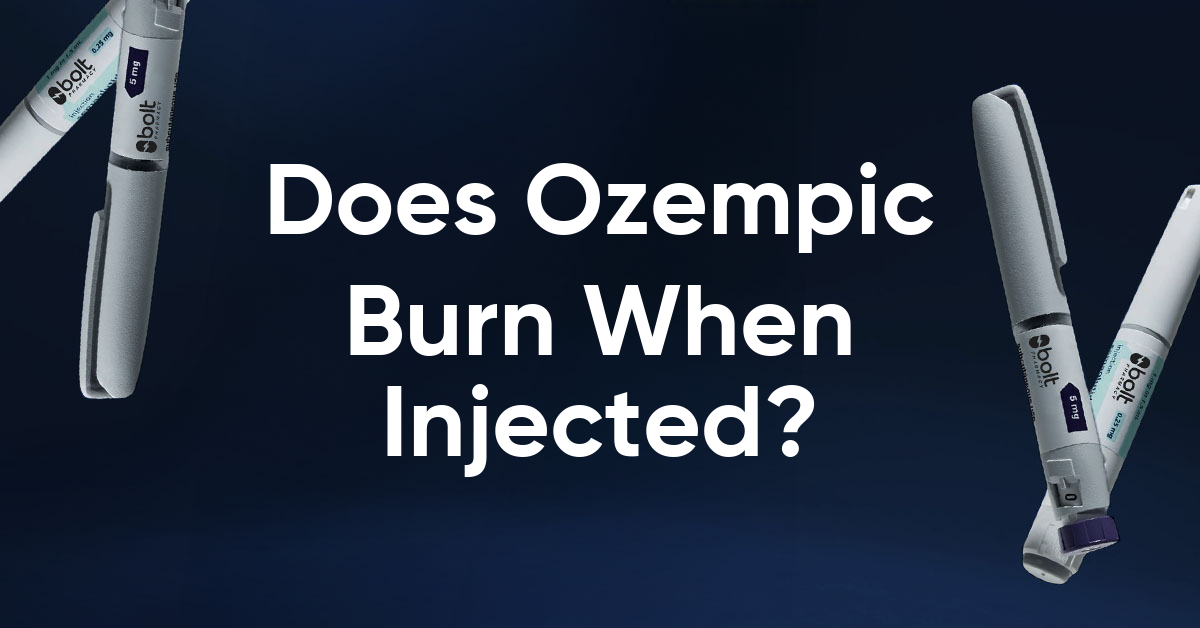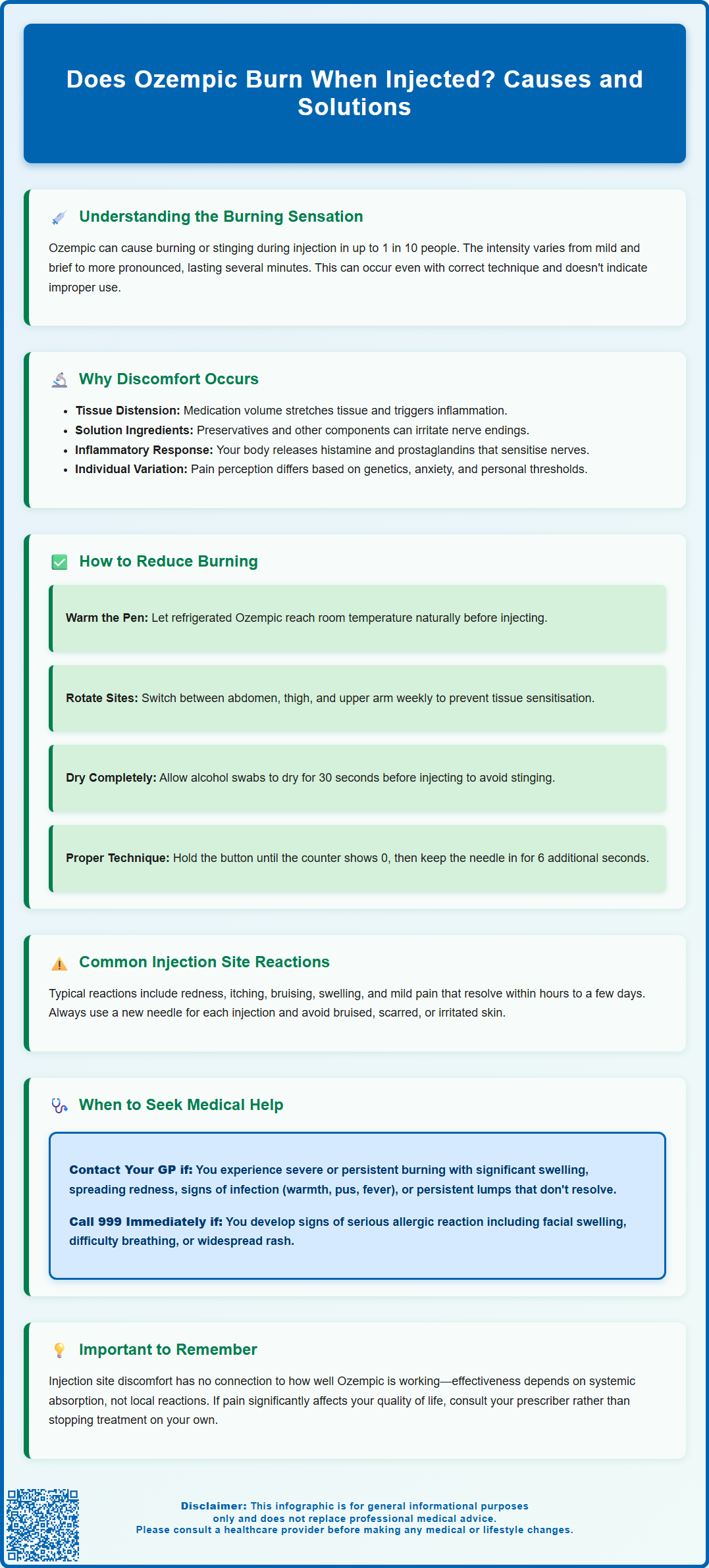Wegovy®
A weekly GLP-1 treatment proven to reduce hunger and support meaningful, long-term fat loss.
- ~16.9% average body weight loss
- Boosts metabolic & cardiovascular health
- Proven, long-established safety profile
- Weekly injection, easy to use

Does Ozempic burn when injected? Many patients wonder about this common concern before starting semaglutide treatment. Ozempic can cause a burning or stinging sensation during or immediately after injection in some individuals, though experiences vary considerably. According to UK product information, injection site reactions are classified as common side effects, affecting up to 1 in 10 people. The intensity ranges from mild, transient discomfort lasting seconds to more pronounced stinging persisting for several minutes. Understanding why this occurs, how to minimise discomfort, and when to seek medical advice helps patients manage their treatment confidently and safely.
Summary: Ozempic can cause a burning or stinging sensation during injection in up to 1 in 10 patients, though intensity varies and the sensation typically resolves within minutes.
Ozempic (semaglutide) can cause a burning or stinging sensation during or immediately after injection in some patients, though this is not experienced by everyone. According to the UK Summary of Product Characteristics (SmPC), injection site reactions are categorised as common side effects, which means they may affect up to 1 in 10 people.
The intensity of burning varies considerably between individuals. Some patients report only mild, transient discomfort lasting a few seconds, whilst others describe a more pronounced stinging sensation that may persist for several minutes after injection. It is important to note that experiencing a burning sensation does not necessarily indicate improper injection technique or product defect — it can occur even when the medication is administered correctly.
If you experience severe, persistent burning accompanied by significant swelling, redness spreading beyond the injection site, or signs of infection (warmth, pus, fever), contact your GP or healthcare professional promptly. If you develop signs of a serious allergic reaction such as swelling of the face, lips or tongue, difficulty breathing, or widespread rash, call 999 immediately. Mild, self-limiting burning that resolves within minutes is generally not a cause for concern, but persistent or worsening symptoms warrant medical review to rule out complications.

Several techniques can help minimise injection site discomfort when administering Ozempic. Implementing these strategies may significantly improve your injection experience and adherence to treatment.
Temperature management may help. If stored in the refrigerator, allowing the pen to reach room temperature before injecting may reduce discomfort. Never attempt to warm the pen artificially using hot water, microwaves, or direct heat sources, as this can degrade the medication.
Injection technique considerations include:
Follow the official instructions — press and hold the injection button until the dose counter shows 0, then keep the needle in your skin for 6 seconds to ensure you get the full dose.
Rotate injection sites systematically — use different areas of the abdomen, thigh, or upper arm each week to prevent tissue sensitisation and local skin thickening.
Pinch the skin gently if you are very lean, ensuring the needle enters fatty tissue rather than muscle, which is more sensitive.
Insert the needle at a 90-degree angle in most cases, as recommended in the Patient Information Leaflet.
Pre-injection preparation also matters. Ensure the injection site is clean and completely dry — residual alcohol from cleansing can cause stinging when the needle penetrates. Allow alcohol swabs to evaporate fully (approximately 30 seconds) before injecting. Some patients find that applying a cold compress to the area for 1–2 minutes before injection can provide temporary numbing.
Always use a new needle for each injection, check that the solution is clear and colourless, and avoid injecting through clothing or into bruised, scarred or irritated skin.
If burning persists despite these measures, discuss alternative injection sites or techniques with your practice nurse or diabetes specialist nurse, who can observe your technique and provide personalised guidance.
Injection site reactions are among the most frequently reported local adverse effects of Ozempic, as documented in the UK product information. Understanding the spectrum of normal reactions helps patients distinguish between expected, self-limiting effects and those requiring medical attention.
Common injection site reactions include:
Erythema (redness) — typically appears as a small, circular red area at the injection point, usually resolving within a few days.
Pruritus (itching) — mild itching around the injection site affects some users and generally subsides without intervention.
Bruising (ecchymosis) — small bruises may develop if the needle contacts a capillary; these are harmless and resolve naturally.
Swelling or induration — slight firmness or a small raised area may persist for several hours post-injection.
Pain or tenderness — mild soreness when touching the injection site is common and typically resolves within 24 hours.
These reactions are generally mild to moderate in severity and self-limiting, requiring no specific treatment beyond standard wound care.
Seek medical advice if you experience:
Severe pain that worsens rather than improves
Spreading redness that continues to expand
Warmth, pus, or discharge suggesting infection
Systemic symptoms such as fever or malaise
Persistent nodules or lumps that do not resolve
Call 999 immediately if you develop signs of a serious allergic reaction such as swelling of the face, lips or tongue, difficulty breathing, or widespread rash.
Serious injection site reactions are uncommon with Ozempic based on clinical data, but any suspected adverse drug reaction should be reported via the Yellow Card Scheme (yellowcard.mhra.gov.uk) to contribute to ongoing medication safety monitoring. Your GP or healthcare professional can assess whether reactions represent normal tissue response or require investigation for potential complications.
Understanding the pharmacological and physiological mechanisms behind injection site discomfort can help patients contextualise their experience and recognise that such reactions, whilst unpleasant, are often predictable consequences of subcutaneous drug delivery.
Pharmacological factors that may contribute to discomfort include:
Medication volume — Each Ozempic dose delivers a specific volume of liquid into the subcutaneous space (approximately 0.19 mL for 0.25 mg, 0.37 mL for 0.5 mg, 0.74 mL for 1 mg, and 0.75 mL for 2 mg doses). Even small volumes create localised tissue distension, which can activate pain-sensing nerve endings.
Solution properties — Ozempic contains the active ingredient semaglutide along with excipients including disodium phosphate dihydrate, sodium chloride, phenol (as a preservative), water for injections, and pH adjusters. These components, while necessary for the medication's stability and effectiveness, may contribute to sensations experienced during injection.
Tissue-level responses include:
Mechanical trauma — Needle insertion creates a small wound tract through skin, subcutaneous tissue, and nerve endings, triggering immediate nociceptive signalling.
Inflammatory mediators — Tissue injury, however minor, initiates a localised inflammatory cascade involving histamine, prostaglandins, and cytokines, which sensitise nerve endings and cause the characteristic burning or stinging sensation.
Individual variation in pain perception — Genetic factors, previous injection experience, anxiety levels, and individual pain thresholds all influence how discomfort is perceived and reported.
There is no official link between injection site burning and medication efficacy — experiencing discomfort does not indicate that Ozempic is working better or worse. The therapeutic effect of semaglutide depends on its systemic absorption and action on GLP-1 receptors throughout the body, not on local tissue reactions at the injection site.
If injection site discomfort significantly impacts your quality of life or adherence to treatment, discuss this with your prescriber. Whilst alternative GLP-1 receptor agonists exist, switching medications should be based on a comprehensive assessment of efficacy, tolerability, and individual circumstances rather than injection site reactions alone.
Injection site reactions including burning are classified as common side effects, affecting up to 1 in 10 people according to UK product information. The intensity and duration vary considerably between individuals.
No, injection site burning does not indicate medication efficacy. Ozempic's therapeutic effect depends on systemic absorption and action on GLP-1 receptors throughout the body, not on local tissue reactions at the injection site.
Contact your GP if you experience severe pain that worsens, spreading redness, warmth or discharge suggesting infection, persistent lumps, or systemic symptoms such as fever. Call 999 immediately for signs of serious allergic reaction including facial swelling or breathing difficulty.
The health-related content published on this site is based on credible scientific sources and is periodically reviewed to ensure accuracy and relevance. Although we aim to reflect the most current medical knowledge, the material is meant for general education and awareness only.
The information on this site is not a substitute for professional medical advice. For any health concerns, please speak with a qualified medical professional. By using this information, you acknowledge responsibility for any decisions made and understand we are not liable for any consequences that may result.
Lorem ipsum dolor sit amet, consectetur adipiscing elit, sed do eiusmod tempor incididunt ut labore et dolore magna aliqua. Ut enim ad minim veniam, quis nostrud exercitation ullamco laboris nisi ut aliquip ex ea commodo consequat. Duis aute irure dolor in reprehenderit in voluptate velit esse cillum dolore eu fugiat nulla pariatur.
Block quote
Ordered list
Unordered list
Bold text
Emphasis
Superscript
Subscript